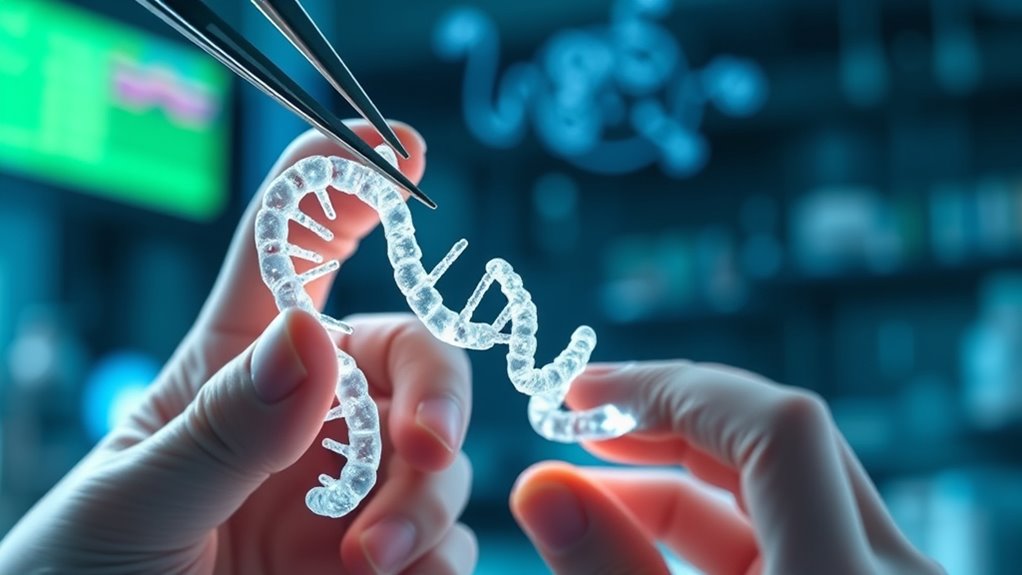CRISPR gene editing holds incredible promise for treating genetic diseases like sickle cell anemia and cystic fibrosis, and it could even enhance human traits in the future. However, it raises important ethical questions about safety, consent, and potential societal inequalities. Off-target effects and long-term impacts remain concerns, and regulatory frameworks are still catching up. To understand how scientists are working to balance hope with caution, explore the complexities behind this groundbreaking technology.
Key Takeaways
- CRISPR offers precise gene therapy potential for treating inherited diseases like sickle cell anemia.
- Ethical concerns include unintended mutations, long-term safety, and impacts on future generations.
- Off-target effects and unpredictable genetic changes pose risks requiring advanced safety measures.
- Ethical issues involve consent, genetic inequality, and potential misuse for enhancement or environmental modification.
- Regulatory frameworks are necessary to balance scientific progress with societal, ethical, and safety considerations.
The Science Behind CRISPR Technology

Have you ever wondered how scientists can precisely edit genes within living organisms? It all comes down to understanding the Cas9 mechanism. Cas9 is an enzyme that acts like molecular scissors, guided by a specific RNA sequence to target exact DNA locations. Once it finds its target, Cas9 creates a break in the DNA strand, initiating the cell’s natural DNA repair processes. This repair can lead to the insertion, deletion, or correction of genetic material. The efficiency of this process relies on harnessing DNA repair mechanisms, such as non-homologous end joining or homology-directed repair. By controlling these repair pathways, scientists can precisely modify genes, paving the way for groundbreaking advancements in medicine and biotechnology. Understanding DNA repair mechanisms is crucial for optimizing gene editing techniques.
Promising Medical Applications of Gene Editing
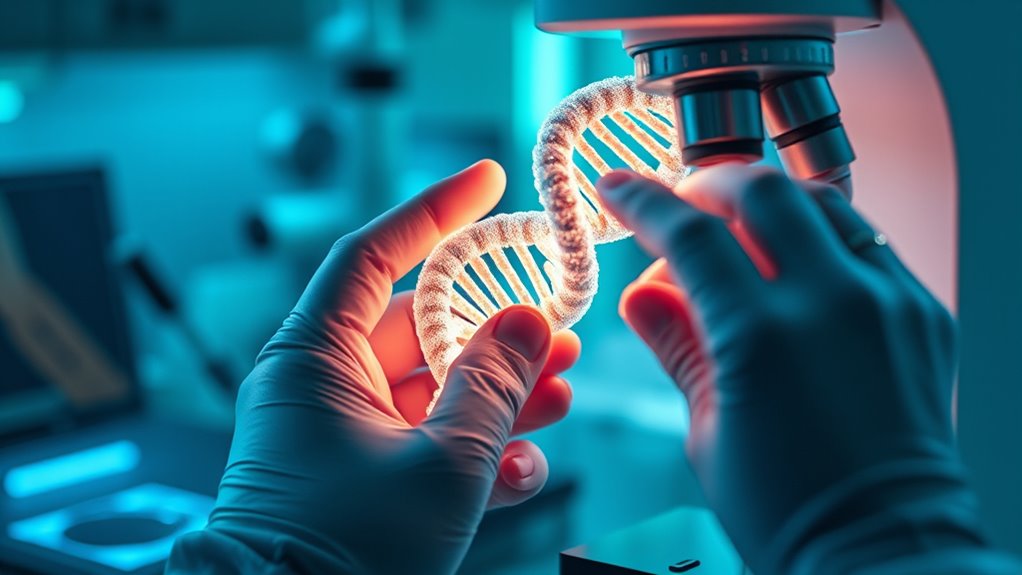
Gene editing holds immense promise for transforming medicine by offering targeted treatments for various diseases. You can see its potential in gene therapy, where CRISPR corrects genetic mutations responsible for inherited conditions like sickle cell anemia and cystic fibrosis. This technology allows for precise modifications, reducing the need for more invasive treatments. Beyond treating diseases, gene editing also opens doors to genetic enhancement, potentially improving traits such as immunity or physical abilities. Researchers are exploring ways to boost resistance to infections and even slow aging processes. As you consider these applications, it’s clear that gene editing can revolutionize healthcare, providing personalized, effective solutions. While challenges remain, the promise of safer, more efficient therapies makes gene editing a milestone in medical science. Additionally, advancements in biomedical research continue to support the development of innovative treatments and expand our understanding of genetic functions. The ongoing refinement of gene editing techniques aims to improve safety and reduce unintended effects, further paving the way for widespread clinical use. Increasing attention to ethical considerations is crucial to ensure responsible development and application of these powerful technologies.
Ethical Dilemmas and Moral Considerations
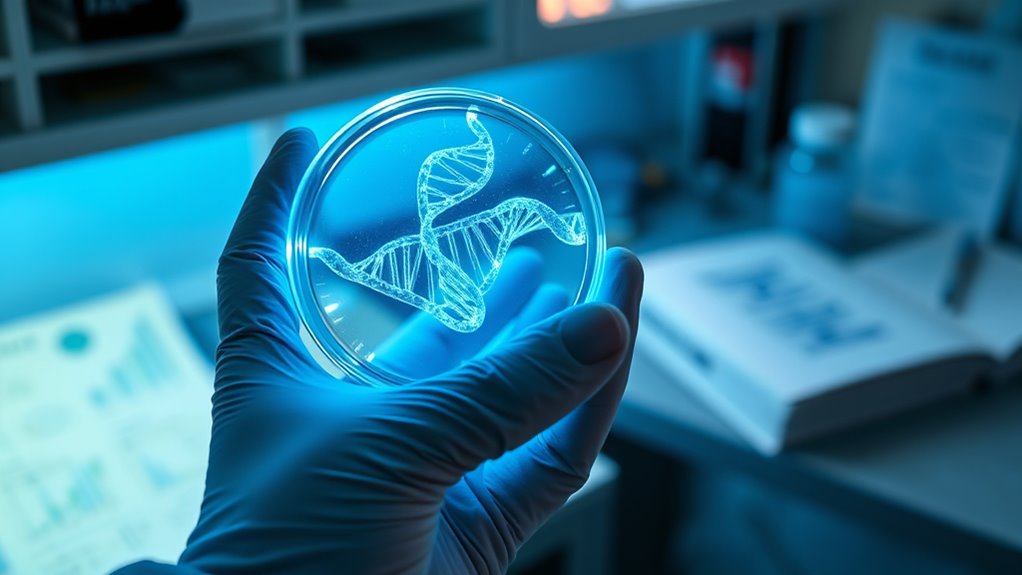
You might wonder about the risks of germline modifications and how they could affect future generations. Consider the ethical questions surrounding who has access to this technology and whether it could widen social inequalities. These moral dilemmas demand careful thought as we decide how to responsibly use CRISPR. Additionally, understanding ethical hacking principles can guide the development of safer and more sustainable gene-editing practices. The potential for unintended cybersecurity vulnerabilities in gene editing systems underscores the need for robust security measures to prevent misuse.
Germline Modification Risks
While CRISPR gene editing offers remarkable potential for eradicating genetic diseases, it also raises significant ethical and moral concerns when applied to the germline. Modifying germline cells means changes are passed down through genetic inheritance, affecting future generations. This process involves complex biotechnological techniques that require careful oversight to prevent misuse. This raises questions about unintended consequences and long-term societal impact. You must consider the risks of creating unforeseen mutations or disparities. Additionally, the genetic diversity within populations could be impacted by widespread germline modifications, potentially reducing resilience to diseases. Moreover, the development of Cultural Intelligence can play a role in understanding diverse perspectives on genetic modifications and ethical considerations. Here’s a quick look at some key issues:
| Ethical Concern | Societal Impact |
|---|---|
| Unpredictable genetic changes | Potential for new inequalities in society |
| Consent and autonomy | Future generations cannot consent to modifications |
Equity and Accessibility
How accessible is CRISPR technology to different populations, and what ethical questions does this raise? Accessibility disparities and socioeconomic barriers mean that some groups may benefit less from gene editing. This raises concerns about inequality and fairness. Consider these points:
- Wealthier nations and individuals might access advanced treatments first, widening health gaps.
- Limited resources in low-income regions restrict participation and benefit.
- Ethical dilemmas emerge around prioritizing who receives treatments and preventing exploitation.
- The potential for merchants and vendors to influence access and distribution further complicates equitable implementation.
Additionally, the lack of global standards and regulatory frameworks can hinder fair distribution and oversight of gene editing technologies. The absence of established ethical guidelines can lead to misuse or unethical applications. You must ask: does this technology promote equal health opportunities or deepen existing disparities? If access remains unequal, it risks creating a divided society where only the privileged benefit from genetic advancements. Ensuring equitable access is essential to address these moral concerns and prevent further social injustice.
Risks and Unintended Consequences
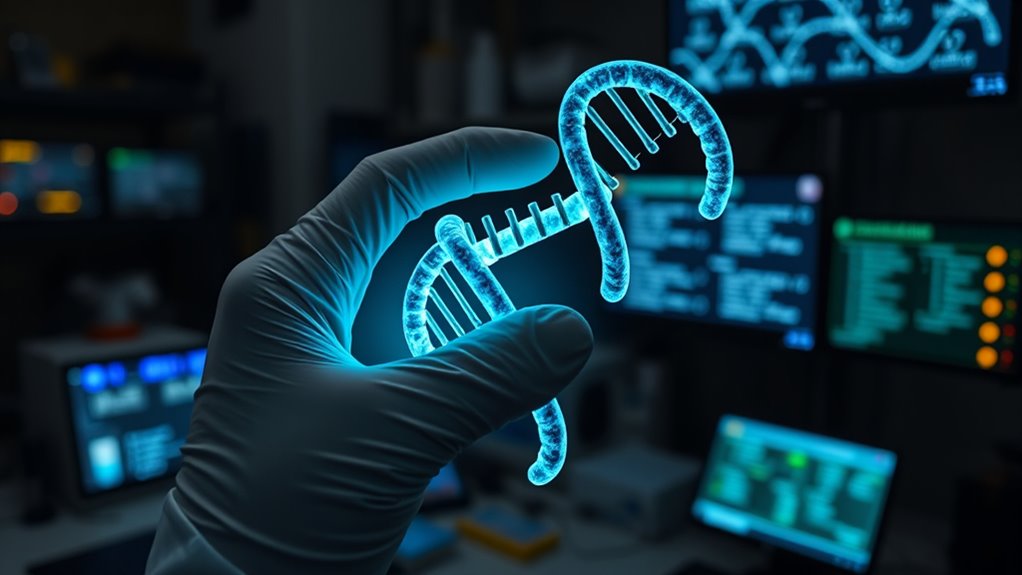
You need to contemplate the risks of off-target mutations, which can cause unintended genetic changes. These errors might lead to harmful effects that are hard to predict or control. Additionally, the long-term consequences of gene editing remain uncertain, raising concerns about future health and ecological impacts. Research into the predictive validity of assessment tools highlights the importance of thorough evaluation to understand and mitigate potential risks. Moreover, ongoing advancements in glycolic acid benefits for skin help inform safety standards to minimize adverse effects. Understanding retirement planning strategies can also provide insights into managing long-term uncertainties effectively.
Off-Target Mutations Risks
Off-target mutations pose a significant concern in CRISPR gene editing because unintended changes to the DNA sequence can occur if the guide RNA binds to similar but incorrect locations. These off target effects threaten mutation safety, raising questions about precision. To minimize risks, you should consider: 1. Carefully designing guide RNAs to target unique sequences, reducing unintended binding. 2. Employing advanced detection methods to identify off-target effects early. 3. Developing improved CRISPR variants with higher specificity to prevent unwanted mutations. Additionally, ongoing research into AI safety measures can aid in developing better predictive models for off-target effects and enhance the overall safety of gene editing technologies. Implementing high-fidelity enzymes can further reduce the likelihood of off-target activity, ensuring more precise editing outcomes. Moreover, integrating robust safety protocols is essential for responsible application of these powerful techniques.
Long-term Unpredictability Concerns
While advancements in guide RNA design and detection methods help reduce immediate risks, long-term effects of CRISPR interventions remain uncertain. You might achieve desired gene edits now, but questions about long-term stability persist. Unpredictability concerns center on how these edits could behave over decades, potentially causing unforeseen health issues or genetic changes that aren’t evident today. Because human biology is complex, you can’t fully anticipate how edited genes will interact within the genome over generations. This uncertainty raises ethical questions about releasing such modifications into humans or the environment. You need to contemplate that, despite current successes, the long-term safety and stability of CRISPR edits are still unclear, making unpredictability concerns a significant barrier to widespread adoption. Moreover, the long-term stability of these edits depends on complex biological interactions that are not yet fully understood. Additionally, ongoing research into genetic interactions aims to better predict how edits will perform over extended periods, but the field has yet to reach definitive conclusions.
Regulatory Challenges and Policy Development
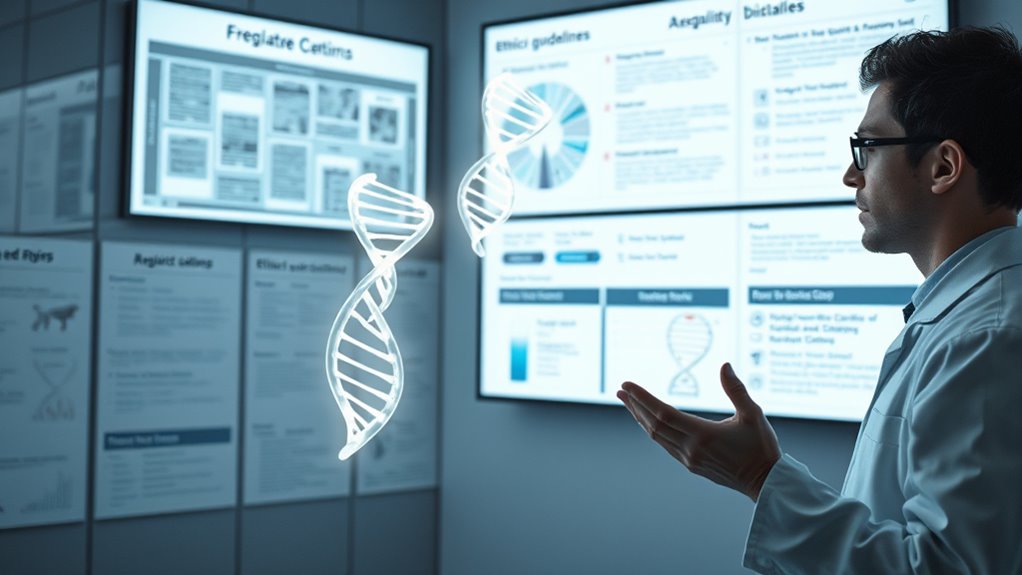
What makes regulatory challenges in CRISPR gene editing particularly complex is the rapid pace of technological advancement outstripping existing policies. You need a solid policy framework that can adapt quickly to innovations, which isn’t always the case. The main issues include:
- Establishing clear national guidelines that balance innovation with safety,
- Creating international regulation to prevent misuse across borders,
- Coordinating policies to address ethical concerns and avoid loopholes.
Without cohesive global standards, researchers might exploit regulatory gaps, risking unethical practices. The challenge lies in developing flexible yet enforceable policies that keep pace with scientific breakthroughs. Effective regulation requires collaboration among countries, ethical oversight, and adaptable frameworks to ensure responsible progress in CRISPR applications.
The Future of CRISPR in Human Health
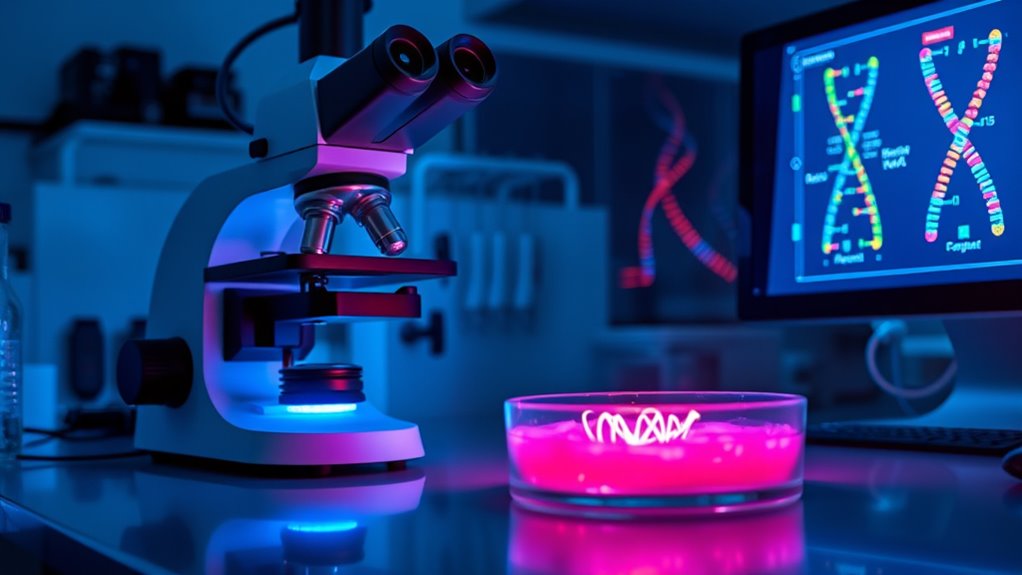
Advances in CRISPR technology are poised to revolutionize human health by enabling precise and personalized treatments. You’ll see potential cures for genetic disorders, cancers, and infectious diseases become more accessible. However, as these innovations develop, concerns about genetic privacy grow. You might worry about how your genetic data is stored and protected, especially with increasing societal perceptions that gene editing could lead to inequality or misuse. Future applications will require careful regulation to balance scientific progress with ethical considerations. Public understanding and acceptance will shape how CRISPR’s benefits are realized. As society debates these issues, you’ll need to stay informed about the evolving landscape of gene editing, ensuring that future health advancements serve everyone ethically and fairly.
Frequently Asked Questions
Can CRISPR Be Used to Edit Human Germline Cells Permanently?
You can use CRISPR for germline modification, allowing heritable editing of human germline cells. This means changes made today can be passed down to future generations. While technically feasible, ethical concerns and regulations often restrict or prohibit such permanent editing. If you pursue germline modification, you’ll need to contemplate the potential impacts on individuals and society, and be aware of the ongoing debates surrounding heritable editing.
What Are the Potential Environmental Impacts of Releasing Gene-Edited Organisms?
You wonder about the environmental impacts of releasing gene-edited organisms. While they could solve ecological issues, they also pose risks like genetic contamination and unforeseen effects on ecosystems. These ecological risks might disrupt biodiversity, harm non-target species, or lead to the spread of modified genes. Balancing innovation with caution is essential, as unintended consequences could ripple through natural environments, creating challenges we might struggle to control or reverse.
How Accessible Will Crispr-Based Therapies Be Worldwide?
You might wonder how accessible CRISPR-based therapies will be worldwide. Currently, cost disparity and regulatory hurdles pose significant challenges. While some countries could see affordable treatments, others may face high costs and strict regulations, limiting access. As technology advances and regulations evolve, accessibility could improve globally, but disparities will likely persist without concerted efforts to address these barriers. Ultimately, equitable access depends on policy, innovation, and global collaboration.
Are There Alternatives to CRISPR With Fewer Ethical Concerns?
You might wonder if there are alternative technologies with fewer ethical considerations than CRISPR. Yes, options like TALENs and ZFNs exist, which also enable gene editing but often face fewer ethical concerns because they are more precise or less efficient, reducing unintended effects. These alternatives offer promising avenues for gene therapy, balancing innovation with ethical considerations, and making them attractive options for researchers seeking to address moral issues.
How Does CRISPR Affect Biodiversity and Ecological Balance?
You might wonder how CRISPR affects biodiversity and ecological balance. By editing genes, you could unintentionally reduce genetic diversity, making ecosystems more vulnerable to diseases or environmental changes. It can also disrupt ecosystem stability if modified species outcompete native ones or alter food chains. These impacts could weaken natural resilience, so it’s essential to carefully evaluate CRISPR’s ecological effects before applying it widely.
Conclusion
As you explore CRISPR’s incredible potential, remember it’s a groundbreaking force capable of transforming medicine and ethics alike. While the technology promises cures for diseases once thought unbeatable, it also demands careful moral navigation to prevent unintended chaos. Your choices and policies today will shape a future where gene editing could redefine humanity itself—an extraordinary leap that requires wisdom, caution, and unwavering responsibility to guarantee it benefits everyone without releasing chaos.
